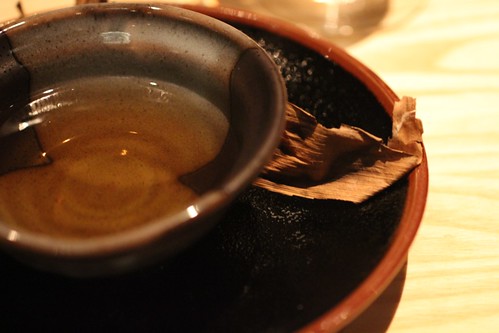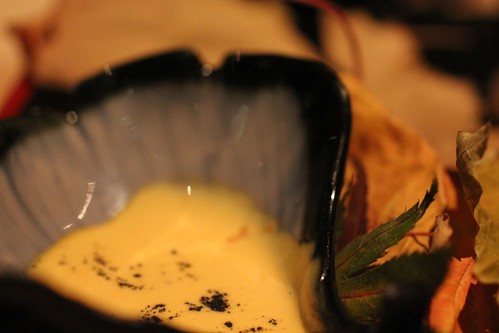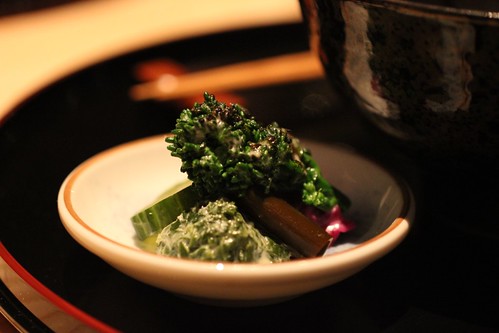
A corn husk broth, simple and remarkably satisfying.
If Michelin ever actually wrote a review of Next, which it apparently refuses to do, it would say less about Grant Achatz and chef Dave Beran’s ever-changing dining experience than the fact that Next seems to make Michelin’s head explode does. If Michelin is all about adhering to a rigid set of standards, Next is all about doing it new every time— and about a virtuosity that mocks the claims of authenticity that are at the heart of Michelin’s traveler’s guide mission. The guidebook to what to eat there meets the restaurant that brings every there to here.
But having eaten Next two and a half times— the half was noshing about half the El Bulli menu in the kitchen while it was being photographed on opening night— I think it’s not hard at all to see the consistent restaurant under the changing themes. Sourcing is more diligent and far-reaching than anywhere in town, technique is extremely refined and precise, though sometimes too much of it can be applied— pastas seem to be a problem and the chicken noodle (made mostly of meat glue) in the Childhood menu was an example of a trick that was better to contemplate than to actually eat.
Each meal is essentially theatrical as much as culinary, though the danger of coming off like EPCOT is always in their minds. So the menus, even when they follow a traditional format like kaiseki, also function as a kind of wordless narrative which takes us through the moods of the cuisine in question, with certain evocative tropes— like scattered leaves— which obviously have meaning to Achatz and Beran (both small town Michigan-raised) reappearing across wildly different themes. You’re dining within someone else’s dream of a culture.
In contrast to the kitchen’s exacting, if unspoken, vision, the atmosphere at Next still has some of the casualness of the relatively low-priced adventure that it started as (but quickly ceased being when it turned out that demand was through the roof). The staff seems young and sometimes a little giddy, their enthusiasm about what Chef has done shading toward fannishness; and the room is deliberately neutral, meant to evoke a train station leading you away (but also reminding one of a simple storefront theater where Shakespeare and Mamet get the same minimalist setting).

A sauce for one dish.
I liked the conceptualness of Childhood as a show, but didn’t come away desiring any of the dishes again. Kyoto, hewing closer to a real-world model, is far more successful in food terms. I’ve had kaiseki and omakase meals before, and this wasn’t the most out-there by any means; this meal at Sankyu, for instance, was more of a mind-blower in terms of strange textures and new experiences. But the microfocused precision of Japanese food is as good a fit for Next as anything they’ve done, and the meal was, simply, beautiful, a series of exquisitely executed dishes which gained in dramatic effect from their placement within the Next storyline, which took us from fall to winter, and in and out of the farm and the sea. And in and out of Japan and the midwest; a number of dishes were altered to make use of American ingredients, introducing homey midwestern flavors like corn or maple into a Japanese-context dish and, somehow, producing the shock of the familiar as palates prepared for the exotic were suddenly taken back to, well… childhood.
Things I remember as particular delights— a smoky corn husk broth which set the autumnal tone, and was amazingly satisfying and comforting; duck prosciutto, pretty as ribbon candy, tucked among the leaves of a “forest floor” course; a maple-tinged chawanmushi; a hearty broth, similar to the ramen they’ve been serving at The Aviary, served with wagyu beef; a persimmon filled with persimmon gelee and accompanied by edible maple leaves (and lots of powdered sugar; they were a bit bitter). Some courses were overly salty, especially a course of fried items, and though the robata-style box with pieces of brook trout was a cool presentation, I suspect it was a more exciting dish on days when it came with eel, as it apparently does.
And for this meal, not wanting to lose the delicacy of the meal in alcohol, I chose the non-alcoholic pairings and had a fascinating, if not always easy, series of teas and concocted sodas— though there was one, using roasted barley, which immediately conjured up a very midwestern picture indeed. I even passed it around and the same thought occurred to others in our party— “Convenience store on the highway.” Somehow the roasted barley suggested, with remarkable precision, the smell of a 7/11-type mini-mart downstate, mixing coffee burning in industrial pots with donuts in the air, maybe a little pine-scented air freshener. The power of food to evoke specific places at Next is truly extraordinary, even when it may not be intentional.

Pickled complements to something or other. See more of my photos at Grub Street.
* * *
Before Next I stopped at La Sirena Clandestina, John Manion’s South American-inspired restaurant (see my interview with him here), to have the drink that would take the edge off and ease me into an evening of non-alcoholic pairings. (As it turned out, Next had the same idea; even the non-alcoholic meal started with sake.) I didn’t taste anything, but I could tell I’d be happy hanging out here and eating Manion’s Brazilian comfort food.
And so I did and I was. La Sirena Clandestina reminded me of its neighbor down the next block, Vera, which is never a bad comparison— the restaurant with the least touristy frillery evoking the place turns out to be the one most true to the spirit. (Well, never bad except to Michelin, who overlooked my favorite restaurant of the year entirely in favor of mediocre white tablecloth spots.) I’ve been kind of burned out on South American food in Chicago— too much of it seems muted, like canned food, a dim reflection of what must be brighter and livelier at home. Manion puts the life back into South American flavors in dishes that had the freshness of good ingredients, whether it was an empanada filled with sharp, funky lamb merguez, a tart shaved brussel sprout salad, or massive shrimp dripping with butter, char flavor and the sea. Best of all is moqueca, something like a South American risotto in that shrimp, mussels and some kind of white fish sit atop a heat-tinged soupy rice which is incredibly comforting (but has too much kick to be lulling). As at Vera, things tastes like themselves and are never dressed up to the point of losing themselves; only enough to be even more of themselves. There’s an essential honesty to the cooking that puts La Sirena instantly among my favorite openings of the year.
* * *
Strikingly similar to some of La Sirena’s stewy dishes is a dish like the African chicken at Fat Rice, a comforting dish full of good fresh finds (hunks of potato or whatever) hidden beneath its main protein. Otherwise Fat Rice, which is mostly Asian and specifically aimed at recreating Macanese food (the food of the Portuguese colony of Macau, and its European influences), is mostly about Asian flavors, but there are similar virtues in the way it highlights fresh ingredients. The dishes that have equivalents in local Asian restaurants bring brightness and clean flavors to sometimes muddled dishes like potstickers or the flat noodles in XO sauce.
Other dishes are, mostly, just simple and good— a crispy grilled sardine, or a clear pumpkin broth. I don’t think the food is as sharpened to a fine point of finesse as Manion’s food at La Sirena is; his is great out of the gate, Fat Rice (which just opened a week ago; we may in fact have been the first customers to actually eat on its opening night, though it had been doing soft opening dinners for several days) will be more of a journey of discovery. As comfortable as a dish like the African chicken is, you want to believe there’s a sharper, more refined dish to be found within it. Yet there’s so much to like here already in terms of good ingredients and honest approach that it, too, becomes an immediate favorite; I will be happy to see how it’s progressing every few months or so. And to congratulate when it wins a Bib Gourmand, Michelin’s pat on the head to restaurants they don’t quite get, but feel like they should be seen to like a little.
Disclosure: I was known to, and comped some items at, both La Sirena Clandestina and Fat Rice.
Tags: fat rice, la sirena clandestina, next kyoto

 If you like this post and would like to receive updates from this blog, please subscribe our feed.
If you like this post and would like to receive updates from this blog, please subscribe our feed.




